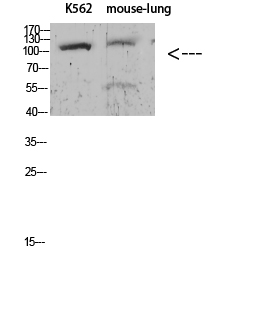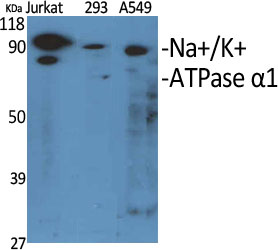Sodium Potassium ATPase (PTR2543) Mouse mAb
- Catalog No.:YM4684
- Applications:IHC;ELISA
- Reactivity:Human (predicted: Mouse; Rat)
- Target:
- Na+/K+-ATPase
- Fields:
- >>cGMP-PKG signaling pathway;>>cAMP signaling pathway;>>Cardiac muscle contraction;>>Adrenergic signaling in cardiomyocytes;>>Insulin secretion;>>Thyroid hormone synthesis;>>Thyroid hormone signaling pathway;>>Aldosterone synthesis and secretion;>>Aldosterone-regulated sodium reabsorption;>>Endocrine and other factor-regulated calcium reabsorption;>>Proximal tubule bicarbonate reclamation;>>Salivary secretion;>>Gastric acid secretion;>>Pancreatic secretion;>>Carbohydrate digestion and absorption;>>Protein digestion and absorption;>>Bile secretion;>>Mineral absorption
- Gene Name:
- ATP1A1
- Protein Name:
- Sodium/potassium-transporting ATPase subunit alpha-1 (Na(+)/K(+) ATPase alpha-1 subunit) (EC 3.6.3.9) (Sodium pump subunit alpha-1)
- Human Swiss Prot No:
- P05023/P50993/P13637/Q13733
- Rat Gene Id:
- 24211
- Rat Swiss Prot No:
- P06685
- Immunogen:
- Synthesized peptide derived from human Sodium Potassium ATPtase AA range: 150-250
- Specificity:
- This antibody detects endogenous levels of Sodium Potassium ATPtase at Human, Mouse,Rat
- Formulation:
- PBS, pH7.4, 50% glycerol, 0.03%Proclin 300
- Source:
- Mouse,monoclonal:IgG3,Kappa
- Dilution:
- IHC 1:50-200,ELISA 1:5000-20000
- Purification:
- Protein G
- Storage Stability:
- -15°C to -25°C/1 year(Do not lower than -25°C)
- Other Name:
- Sodium/potassium-transporting ATPase subunit alpha-1 (Na(+)/K(+) ATPase alpha-1 subunit) (EC 3.6.3.9) (Sodium pump subunit alpha-1)
- Observed Band(KD):
- 110kDa
- Background:
- ATPase Na+/K+ transporting subunit alpha 1(ATP1A1) Homo sapiens The protein encoded by this gene belongs to the family of P-type cation transport ATPases, and to the subfamily of Na+/K+ -ATPases. Na+/K+ -ATPase is an integral membrane protein responsible for establishing and maintaining the electrochemical gradients of Na and K ions across the plasma membrane. These gradients are essential for osmoregulation, for sodium-coupled transport of a variety of organic and inorganic molecules, and for electrical excitability of nerve and muscle. This enzyme is composed of two subunits, a large catalytic subunit (alpha) and a smaller glycoprotein subunit (beta). The catalytic subunit of Na+/K+ -ATPase is encoded by multiple genes. This gene encodes an alpha 1 subunit. Multiple transcript variants encoding different isoforms have been found for this gene. [provided by RefSeq, May 2009],
- Function:
- catalytic activity:ATP + H(2)O + Na(+)(In) + K(+)(Out) = ADP + phosphate + Na(+)(Out) + K(+)(In).,function:This is the catalytic component of the active enzyme, which catalyzes the hydrolysis of ATP coupled with the exchange of sodium and potassium ions across the plasma membrane. This action creates the electrochemical gradient of sodium and potassium ions, providing the energy for active transport of various nutrients.,PTM:Phosphorylation on Tyr-10 modulates pumping activity.,similarity:Belongs to the cation transport ATPase (P-type) family.,similarity:Belongs to the cation transport ATPase (P-type) family. Type IIC subfamily.,subcellular location:Identified by mass spectrometry in melanosome fractions from stage I to stage IV.,subunit:Composed of three subunits: alpha (catalytic), beta and gamma. Binds the HLA class II histocompatibility antigen, DR1.,
- Subcellular Location:
- Basolateral cell membrane ; Multi-pass membrane protein . Cell membrane, sarcolemma ; Multi-pass membrane protein . Cell projection, axon . Melanosome . Identified by mass spectrometry in melanosome fractions from stage I to stage IV. .
- June 19-2018
- WESTERN IMMUNOBLOTTING PROTOCOL
- June 19-2018
- IMMUNOHISTOCHEMISTRY-PARAFFIN PROTOCOL
- June 19-2018
- IMMUNOFLUORESCENCE PROTOCOL
- September 08-2020
- FLOW-CYTOMEYRT-PROTOCOL
- May 20-2022
- Cell-Based ELISA│解您多样本WB检测之困扰
- July 13-2018
- CELL-BASED-ELISA-PROTOCOL-FOR-ACETYL-PROTEIN
- July 13-2018
- CELL-BASED-ELISA-PROTOCOL-FOR-PHOSPHO-PROTEIN
- July 13-2018
- Antibody-FAQs
- Products Images

- Human kidney tissue was stained with Anti-Sodium Potassium ATPase (PTR2543) Antibody



